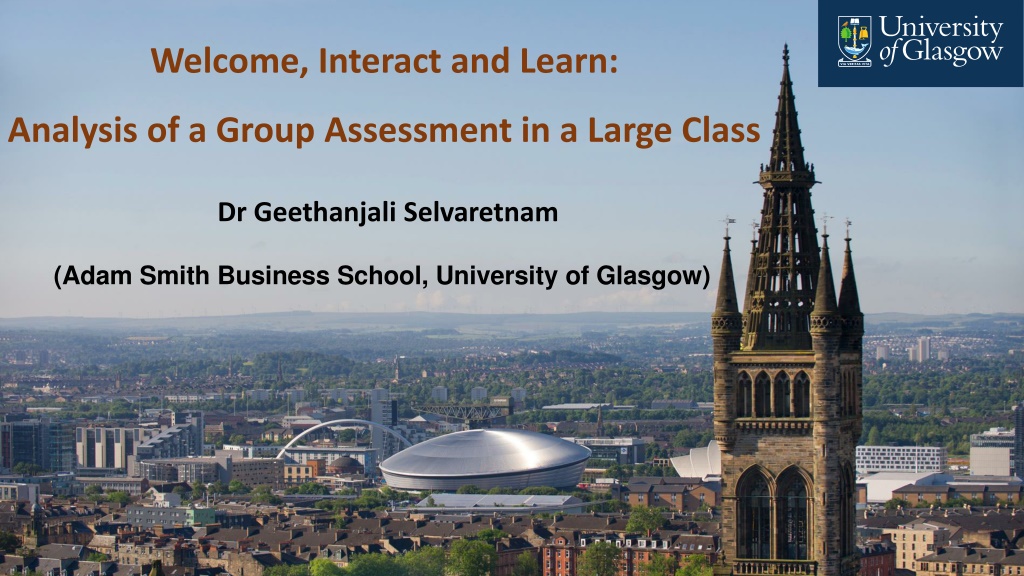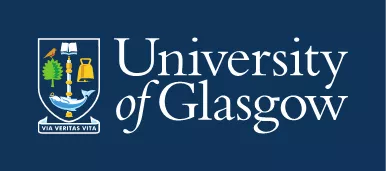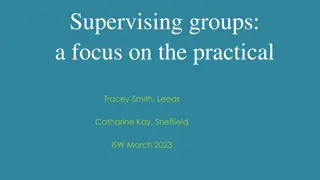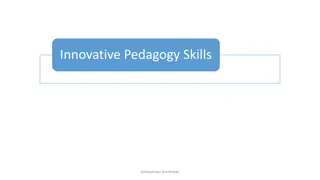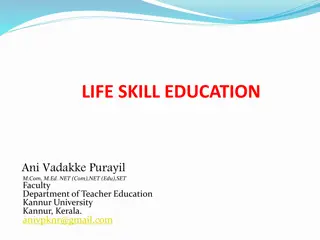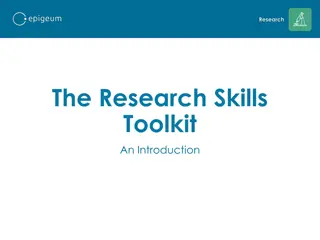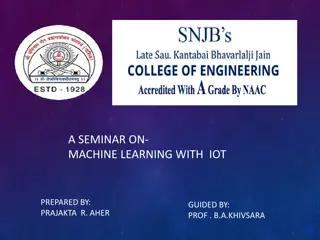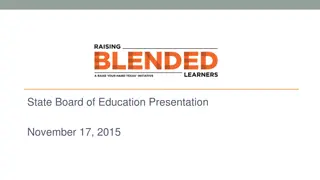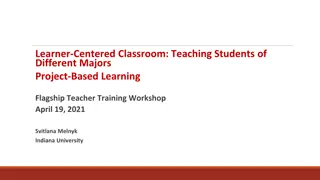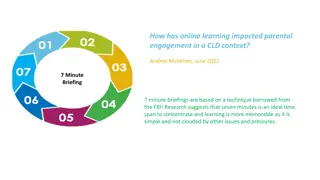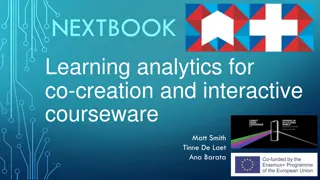Enhancing Group Skills for Diverse Learning
This presentation delves into the use of group assessments in a large class setting to foster cross-cultural interactions, improve learning outcomes, and develop essential group working skills. Issues related to welcoming international students, course challenges, and the importance of early group work introduction are addressed, with a focus on enhancing graduate skills through collaborative learning opportunities.
Download Presentation

Please find below an Image/Link to download the presentation.
The content on the website is provided AS IS for your information and personal use only. It may not be sold, licensed, or shared on other websites without obtaining consent from the author.If you encounter any issues during the download, it is possible that the publisher has removed the file from their server.
You are allowed to download the files provided on this website for personal or commercial use, subject to the condition that they are used lawfully. All files are the property of their respective owners.
The content on the website is provided AS IS for your information and personal use only. It may not be sold, licensed, or shared on other websites without obtaining consent from the author.
E N D
Presentation Transcript
Welcome, Interact and Learn: Analysis of a Group Assessment in a Large Class Dr Geethanjali Selvaretnam (Adam Smith Business School, University of Glasgow)
Objectives of this Presentation Share good practice about the use of a group assessment to tackle some challenges. Share some results from a qualitative analysis about the benefits of this design in terms of developing graduate skills and learning. Share some thoughts on how this design can be improved further. 2
Issue 1 Welcoming GIC Students Large group of students GIC (Glasgow International College) enter in 2nd year. From GIC Total % 2019/20 98 334 29.34 2020/21 180 445 40.45 2021/22 140 473 29.60 Given the size of the new influx, the two groups of students - the existing group, and the delayed arrival - don t seem to interact with each other. Studies have shown that international students value cross-cultural interaction. [Baumeister and Leary (1995), Glass and Westmont (2014), Hausmann et al (2007), Locks et all (2008), Moores and Popadiuk (2011), Osterman (2000), Wang and Mallinckrodt (2006), Wong and Chan (2007)] All our students don t benefit from this multicultural opportunity. Multicultural skills are of great value in the job market. [Arkoudis et al. (2009); Johnson et al. (2006); Ledwith and Seymour (2001)] 3
Issue 2 the Course Economics 2A (Intermediate Microeconomcis) is a large class of more than 400 students. First course that students from GIC take in Economics (2nd year 1st semester) Core course, mathematical analysis and economic interpretations, which students find challenging. Students would benefit from group discussions and revision. During the lock down period, many students would not even get to meet and make new friends and develop study groups. 4
Issue 3 Group Skills Group working skills is essential. Most of our group work activities have been designed into honours courses. (although students do work in groups in weekly sessions, we need this in a more formal setting). Students have repeatedly mentioned that group work should be introduced earlier in the degree, which has many benefits. - This would develop their skills without the pressure of the grades as much. - More willing for such assessments. - More willing to work with students from different backgrounds and skills. - Develop the skills so that they are better prepared in the honours courses, and the future. 5
Four Assessments (in 2021/22) Further group skill development Group MCQ 1 Group assessment 2 (10%) (10%) Revision Revision Before 2021/22 Degree exam In course exam 1 (40%) (40%) Today s presentation concentrates on Group MCQ 1
Group Description The original plan was to have groups with 2 students from GIC and a group size of around 6. Recall we had 473 students in total with 140 students from GIC. But we ended up with: - 81 groups - 68 groups of 6 and 13 groups of 5. - 59 groups had 2 GIC students and 22 groups had only 1) Lesson Students moving across courses created some confusion to our original plan. Would be better to have 70 groups so that we have 2 GIC students in each group. 53 groups with 7 students and 17 with 6 students
Assessment 1 - Group MCQ Assessment Assessment was in week 7, covering material from weeks 1 -5. 10% of the Total grade 30 challenging MCQ questions, which facilitate some thinking, working and discussion. Groups were created 3 weeks before the assessment so that students can get to know each other and decide how they wish to tackle the group assessment. Same groups continue for the Group assessment 2. Assessment was released 3 days before the deadline to give time for discussion Monday). Submission by one group representative on Thursday. To complete the assessment, all students to individually submit responses to one Survey questionnaire to reflect on the experience.
Survey Questionnaire Survey is not graded, although compulsory. Survey questions elicited information about - learning - Interaction - participation This research has the ethics approval and only include those who consented. Survey which followed the Group MCQ 1 had - 6 Likert types questions - 2 Open-ended questions - question about unengaged group members
Likert questions (1) My group members contributed well to complete this assessment. (2) The opportunity to do these questions as a group enhanced my understanding of the material. (3) I would get a better grade because we did the assessment as a group. (4) I will continue to interact with at least some of my group members. (5) I benefitted by this opportunity to interact with students from diverse cultural backgrounds which may not have happened otherwise. (6) Before the group discussion, I had myself attempted (numbers of questions). Open-ended questions: (7) Reflect on the benefits of working in a group to answer the questions and how this experience has developed your team working skills. (8) Reflect on the challenges when working in a group to complete this assessment and how you overcame these. Non-Engagement (9) If you wish, you may name the member(s) of your group who did not contribute to this assessment at all.
Objectives of Assessment Design Revision opportunity for the ICE, which makes up 40%. Opportunity for active learning. Group skill development. Interaction across students from different backgrounds. Survey questionnaire allows students to reflect upon the learning and skill development which happened during the group work. Deter free-riding over the two group assessments and develop group work ethic, as well as taking steps to draw group members in.
(9) Name the member(s) of your group who did not contribute to this assessment We contacted all those who were named and had a discussion about their engagement. Some students explained their contribution, although group deemed it insufficient. I explained to both sides about why we are allowing the grade, but reiterated the importance of better engagement and facilitating that. We did not have a dispute that could not be resolved. If there was totally no engagement, Grade H (zero).
Group Assessment 1 Assessment 2 5 Unengaged in the total course 5 Unengaged in group, but engaged in individual assessments Those who did not engage in the 1st, did engage in the 2nd. Those who engaged in the 1st, did not engage in the 2nd. 3 3 10 10 Non submission by one group. 5 18 23 Lesson: We could have reiterated that some students had received H because of non-engagement after Group assessment 1. Submission of a group project we should send a notification to all students when the submission is made. Meet with the students who had decided to be unengaged in group work (3 fully unengaged)
(1) My group members contributed well to complete this assessment 200 176 180 160 140 1% 120 6% 100 77 80 60 28% 40 16 20 4 0 65% Strongly Agree Agree Neutral Disagree Strongly Disagree Strongly Agree Agree Neutral Disagree Strongly Disagree 14
(2) Opportunity to do these questions as a group enhanced my understanding of the material 140 130 120 100 100 80 60 5% 40 30 11% 13 20 0 Strongly Agree Agree Neutral Disagree Strongly Disagree 47% 37% Strongly Agree Agree Neutral Disagree Strongly Disagree 15
(3) I would get a better grade because we did the assessment as a group 120 96 95 100 80 62 60 40 20 7% 20 0 35% 23% Strongly Agree Agree Neutral Disagree Strongly Disagree 35% Strongly Agree Agree Neutral Disagree Strongly Disagree 16
(4) I will continue to interact with at least some of my group members 140 128 120 100 75 80 1% 60 51 6% 40 17 27% 20 19% 2 0 Strongly Agree Agree Neutral Disagree Strongly Disagree 47% Strongly Agree Agree Neutral Disagree Strongly Disagree 17
(5) I benefitted by this opportunity to interact with students from diverse cultural backgrounds which may not have happened otherwise 140 120 120 100 88 80 2% 60 42 6% 40 17 20 6 16% 32% 0 Strongly Agree Agree Neutral Disagree Strongly Disagree 44% Strongly Agree Agree Neutral Disagree Strongly Disagree 18
(6) Before the group discussion, I had myself attempted 152 160 140 120 100 80 60 60 45 6% 40 16% 16 20 0 All questions > 20 11-20 0-10 56% 22% All questions > 20 11-20 0-10 19
Qualitative analysis: Coding and Thematic analysis (7) Reflect on the Benefits of working in a group to answer the questions and how this experience has developed your team working skills. (8) Reflect on the Challenges when working in a group to complete this assessment and how you overcame these. 20
Challenges Meeting (112 comments) Meeting difficulties - time zone difficulty in arranging time for discussion, as not all members were in Glasgow or available at the same time. In this situation it worked well to divide the group into 2, and then discuss all together via text. difficult to engage with those in different time zones, group chat helped with different time zones. It was challenging to have everybody communicate at the same time, as some in our group have a substantial time difference. 38 Finding a convenient time to meet Everyone has got different schedules and it is quite hard to set up a meeting where we can all participate. We required multiple unnecessary meetings just to interact with everyone. Managing to get a time when everyone was available to meet. 36 Meeting in person Finding a time a place to meet, however we ended up doing it on zoom instead . Covid restrictions challenges. we overcame these challenges by meeting on zoom. May have been slightly easier if we had been able to work on the quiz in person. 23 COP26 The only challenges we had were about meeting up during cop so we used zoom. Organising a meeting during COP26 was hard but we sorted it out. 3 21
Challenges completing the assessment (56 comments) Coming to agreement on the answer when there are different answers At points it was frustrating to come to an agreement, as different members had conflicting answers. This was resolved by getting more members to look over this question in more depth. I had different answers to some questions, but we could not convince each other, so we had to obey the choice of the majority of the team members. 53 Embarrassment or nervous of lack of knowledge My personal anxiety made it difficult for me to share my answers to the extent I wanted. Sometimes I felt embarrassed if I didn t know something but once I overcame that it was helpful. 3 22
Challenges Engagement and Communication (39 comments) No communication - Disengaged members People didn't communicate at all, so this was a drawback. We tried to communicate with them on different platforms however we still couldn't contact them. When I ask the reason for choosing an answer for question to some members in my group, they simply muted themselves and did not answer. 15 Unequal contribution and some unengaged members The only challenge was that 1/3rd of our group did not contribute any working to this assessment. We tried to contact them but did not receive any response. Some members end up doing more work than others. 10 Language communication barrier English is not my native language, so first of all, I most worried about is whether the smooth communication and team members, so I was trying to finish before we discuss the all questions and to sort out the problem. I think the most challenges for me is the language problem. 11 Members don't speak when we meet The challenge is that no one speaks at the beginning, so I will force the topic to start. Not everyone is as willing to speak up. 3 23
Challenges Technology (17 comments) Communication methods which suited everyone Biggest challenge is definitely communication and organisation, we tried to overcome this by creating a social media group chat but it was not very effective. Only challenge really was that someone was in a different country so we had to try communicate the question with them via email. 7 Technical issues when using online platforms such as zoom bad internet which made zoom difficult. because of tech issues it was difficult to hear and respond sometimes. To overcome this, I made use of the chat feature. 6 Not having a good discussion forum not having a dedicated forum for discussion was difficult but we eventually made a WhatsApp group for messaging which was helpful. Communication would have been challenging on the Moodle forum alone. 2 Making first contacts It was difficult to get in contact with the members first. Hard to find everyone. 2 24
Benefits Group skills (208 comments) Confidence/ clear communication, persuasion skills It was a good way to develop persuading skills as we had to try to persuade group members that our answers were correct. It was intimidating sharing answers at first, but it was comforting and helpful to learn other people also find the course and questions challenging. I benefitted from explaining my answers to the other group members and discussing the content/ lectures. Share ideas and discuss It helped me be able to speak to someone about questions rather than just getting told on a lecture. It was nice to share thoughts with others. Working in a team allowed us to share our ideas and helped us come to a conclusion for our answers.. Group work planning and accomplishing We were able to improve our collaborative skills in this group work, and we successfully completed the quiz by dividing up the work and discussing it later in the meeting. Everyone has different strengths and weaknesses so it was good to use these to all of our advantages. we overcame any challenges we faced through early and effective communication. This has developed my team working skills through effective coordination. 53 63 92 25
Benefits Better Learning (56 comments pto) 48 Improve content knowledge and learn different approaches Where I was weak in one topic, someone else was strong and vice versa so I ended up learning from them as we did the test. These different perspectives and approaches to the questions proved useful in furthering understanding. And I can learn from the discussions about the different learning ways of my classmates, which helps me a lot.. we managed to patch holes in our knowledge, so it was helpful for all of us. 8 Critical learning opportunity Group work is always massively beneficial to me, because it allows me to more critically analyse the questions. Working in a group ensured critical thinking when approaching questions. 26
Benefits compare, choose the best 74 Compare individual answer with others, discuss enhances learning The questions were fairly challenging, which meant that after attempting our allocated questions we were able to discuss our methods and come to an agreement on any answers that we were unsure about, or we were struggling to understand .to have a look and compare their answers. Working in a group allowed us to communicate on questions we were not certain about, and insight from group members allowed us to reach a consensus, and therefore better understand the material One benefit is that due to people getting different answers, a discussion follows which really helps to better our understanding of the contents. 10 Higher probability of correct answers and grades relatively high score reflects the benefits of working in a team as individually the results would likely have been worse. The team can improve the working efficiency and accuracy of the answers. 27
Benefits meet, interact and support (51 comments) 33 Opportunity to meet course mates, interact and possibly continue interacting It was really interactive, which I liked. It was good to meet other people studying economics and hopefully in the future we will be able to study together. It was beneficial to interact with students from different cultural backgrounds. I also worked with people who I wouldn't normally, and this was good. 18 Support The benefit was having a support system. Having someone to lean on and work out the problems together was really great experience. It was extremely better than I expected because everyone was friendly, communicative and supportive. (My personal anxiety made it difficult for me to share my answers to the extent I wanted), but my group made it a comfortable and safe environment to share. 28
To-do Current coding can be further subdivided. Analyse the responses to the second survey. This will also give some insight about how the group assessments helped the students with the individual exam. Check how responsive these students would be in future group work. I will contact the course coordinators of a couple of honours courses with group work next year. If I teach a similar course, I will continue soe of these good practices. 29
Thank You !!! Thank You !!! Also, my heartfelt Thank you to - all my students for their cooperation and engagement in a blended learning set-up and group work in challenging times. - Dr Michele Battisti, the course coordinator for his support for this assessment format and leadership. - Ania Doswell, the course administrator who has helped me a lot! Geethanjali.Selvaretnam@glasgow.ac.uk
References Arkoudis, S., Hawthorne, L., Baik, C., Hawthorne, G., O Loughlin, K., Leach, D., & Bexley, E. (2009). The impact of English language proficiency and workplace readiness on employment outcomes and performance of tertiary international student s. Melbourne: Centre for the Study of Higher Education, University of Melbourne. Baumeister, R. F. R., M.R. Leary (1995). The need to belong: Desire for interpersonal attachments as a fundamental human motivation . Psychological bulletin, 117 (3), pp 497 529. Glass, C. R., Westmont, C. M (2014). Comparative effects of belongingness on the academic success and cross-cultural interactions of domestic and international students . International Journal of Intercultural Relations, 38, pp 106 119. Hausmann, L. R. M, Schofield, J. W., & Woods, R. L. (2007). Sense of belonging as a predictor of intentions to persist among African American and White first-year college students . Research in Higher Education, 48(7), pp803 839. Johnson, J.P., Lenartowicz, T., Apud, S. (2006). Cross-cultural competence in international business: toward a definition and a model , Journal of International Business Studies, Volume 37, Issue 4, pp 525-543. Ledwith, S., Seymour, D. (2001). Home and away: preparing students for multicultural management . The International Journal of Human Resource Management, Vol 12, pp 1292 1312. Locks, A. M., Hurtado, S., Bowman, N. A., & Oseguera, L. (2008). Extending notions of campus climate and diversity to students transition to college . The Review of Higher Education, 31(3), pp257 285. Moores, L., & Popadiuk, N. (2011). Positive aspects of international student transitions: A qualitative inquiry . Journal of College Student Development, 52(3), pp291 306. Osterman, K. F. (2000). Students need for belonging in the school community . Review of Educational Research, 70(3), pp323 367. Wang, C.-C. D., & Mallinckrodt, B. (2006). Acculturation, attachment, and psychosocial adjustment of Chinese/Taiwanese international students . Journal of Counselling Psychology, 53(4), pp422 433. Wong, D. F. K., & Chan, C. L. W. (2007). Acculturative stressor and meaning of life as predictors of negative affect in acculturation: A cross-cultural comparative study between Chinese international students in Australia and Hong Kong . Australian and New Zealand Journal of Psychiatry, 41(9), pp740 750. 31
